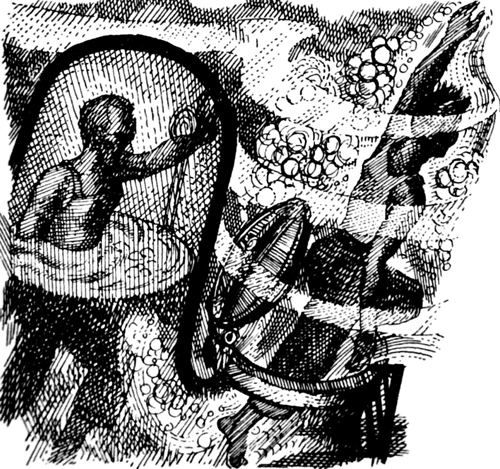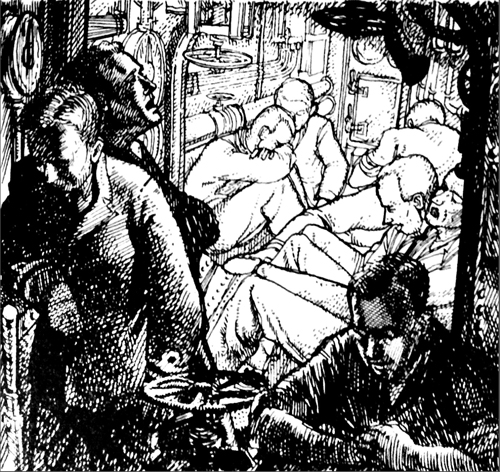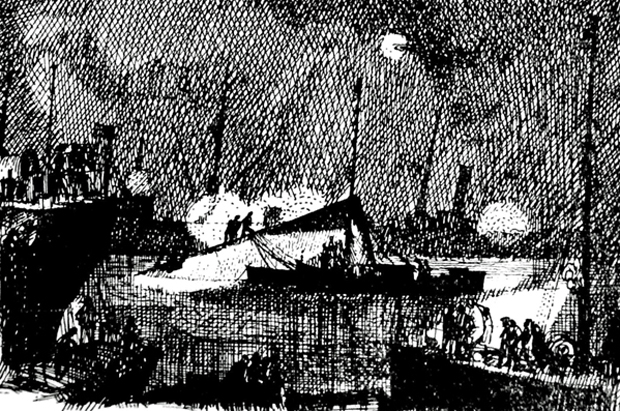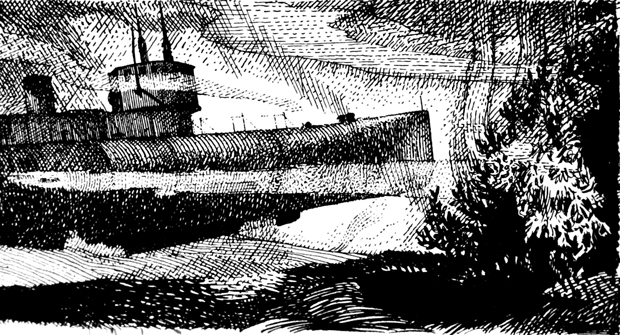ONE of the saddest events in the history of the Gareloch is the K.13 submarine disaster, which took place on January 29 1917.
What follows is the third of four accounts of the tragedy, found recently by Rhu man Alan Dundas. It is a long and fascinating article by Alastair Borthwick illustrated with sketches.
He said: “I found it in the Lithgow Group Winter 1952 magazine that my late mother-in-law had in her papers. My wife’s grandfather, Peter Baxter, was a director in a number of Lithgow companies at that period.”
Here is the article . . .
On the afternoon of 29th January 1917 a housemaid at Shandon Hydro told friends that she had seen two men swimming in the Gareloch out from the shore.
They had, she said, shouted “Oh” and then flung up their arms and disappeared.
About the same time doubts were crossing the minds of two other people on the Gareloch.
One of them was the captain of the submarine E.50 who had been watching the K.13, a new submarine undergoing her acceptance trials, diving offshore from Shandon.
He could not put his finger on the trouble, but there had been something about that last dive which had not looked quite right. He had not liked the look of it.
The other man was Mr Cleghorn, a director of Fairfield, who had watched the dive from a tender. His firm had built the submarine, and fourteen of his men were on board.
The thing which made him a very worried man indeed was the amount of air which had come to the surface after the submarine had disappeared.
The housemaid’s friends refused to listen when she told her story — three days were to pass before anyone took it seriously; but the others wasted no time.
The captain sailed over and dropped a buoy to mark the spot; and Mr Cleghorn telephoned Fairfield immediately to set in train the long series of operations which were to make the K.13 rescue one of the classics of submarine salvage.
At this stage the K.13 was lying on the floor of the Gareloch, 55 feet down, with her bows in the mud, her interior half-full of water, and thirty of the eighty people in her drowned.
She had reached this position in a very simple way.
A member of her naval crew — the vessel had been accepted, and the Fairfield men were only standing by — had signalled before the dive that all openings to the engine-room had been closed down.
But they had not all been closed. Four air inlets to the boiler-room were wide open.
Almost as soon as the dive began the captain knew there was something far wrong; air pressure was drumming in his ears and the depth gauges showed that she was going down much too quickly.
Orders to blow all tanks produced no result. Water began to spout from one of the control-room speaking tubes. The K.13 continued to sink. A few seconds later she came gently to rest on the bottom.
The situation facing the fifty men still alive was a desperate one, for in those days salvage was not the highly organised affair it now is, and no escape apparatus or even an efficient escape-hatch existed in the submarine.
They calculated they had enough air for eight hours, plus an unknown quantity from the compressed air supply; and, so far as they knew, no rescue attempt could even be started until next day.
They had not been due to surface until dusk, and — knowing nothing of the alarm already being felt by their friends — they assumed they would not be missed until then, by which time it would be too dark for anything to be done that night.
The only items on the credit side appeared to be that the after bulkheads were holding under the strain, and the batteries were fully charged; they had light, and the pumps and the air compressor could be worked.
They settled down to wait. Few of them really believed they would ever see blue sky again, for already, after only a few hours, air was running short.
“As the air in our submerged prison became more and more foul,” wrote Mr Percy Hillhouse, naval architect on the Fairfield staff, “so did our breathing be-come more and more difficult, and we had to inhale and exhale with painful rapidity.
“For some the process was carried on only under great pain and difficulty. Many found standing the easiest posture.
“The great majority, however, were rendered more or less inert and apathetic, and lay down anywhere and everywhere, half asleep, half awake, and breathing or snoring noisily. And so the long night passed away.”
Meanwhile a great deal had been happening on the surface. Far from waiting until dawn, the rescuers had been at work almost from the moment when the submarine submerged.
The E.50 and the gunboat ‘Gossamer’ had been standing by continuously, and by 2 a.m. on the 30th, eleven hours after the accident, the ‘Gossamer’ located the K.13 by grappling.
The gunboat had a diving suit, but no diver. A car was sent to Fairfield for the firm’s diver, but when he started to go down to the submarine the ‘Gossamer’ suit, an old one, burst, and the diver was nearly drowned.
Another car trip was needed to fetch the Fairfield suit; and so it was that at eight o’clock in the morning the imprisoned men at last heard footsteps and tapping on the outside of the hull.
They could not even raise a cheer. Indeed, most of them were almost indifferent.
Although they had been below only 17 hours, the air was already so bad that a match could not burn in it. Yet, as events turned out, they were to survive on that same air for 25 hours more.
The K.13 carried two commanders, one of them her own and the other the captain of a sister vessel at that time being built at Fairfield, and these two gentlemen well knew that the chances of rescue would be doubled if the rescuers knew exactly what they were tackling.
When contact was made, they tried to tap out in Morse full details of the situation in the submarine; but for some reason these efforts failed.
They decided that one of them would have to try to reach the surface. Lieutenant Commander Godfrey Herbert of the K.13 was willing to try, but his duty was to remain with his ship until the last.
Commander Francis H.H.Goodhart DSO declared that it would be better for him to make the attempt himself, and so it was decided.
The plan of escape sounds clumsy and complicated in an age when escape hatches are standard equipment in submarines.
Not only did the conning tower have hatches, one in the floor and one in the roof, which could only be opened and closed from below, but there were no arrangements for draining the conning tower.
Furthermore, anyone escaping from it would not find himself clear of the submarine, but swimming in a wheelhouse which was built round the tower, searching for a small hatch in a far corner of the roof.
From this it will be seen that for one man to escape and still leave the way clear for others to follow later if necessary, a second man would have to go with him into the conning tower to close.
Lt Cdr Herbert decided to be the second man; and in preparation for the attempt he ordered the projector compass and its tube to be removed from the hatch, the idea being to give more space and to leave a hole — with a valve to open and close it — in the floor through which the tower could be drained.
He also ordered the steam whistle pipe to be connected up to the compressed air system.
The plan was for both men to enter the tower and close the hatch behind them. Those in the submarine would secure it from below.
 Once inside they would open the sea valve and gradually flood the tower until the pressure was high enough for the upper hatch to be opened.
Once inside they would open the sea valve and gradually flood the tower until the pressure was high enough for the upper hatch to be opened.
Once that was done, high pressure air was to be turned on, and Cdr Goodhart was to be carried by it upwards and outwards in the direction, it was hoped, of the little hatch in the wheelhouse roof.
As soon as he was gone, Commander Herbert would shut off the air supply, close and clip the outer hatch, and knock loudly on the floor. Those below would then open the drain valve to reduce the pressure and allow the Commander to lift the hatch in the floor and so return.
This was the best that could be done, but it was a complicated plan to be worked at high speed, underwater, in an enclosed space. It did not work as intended.
The two men found themselves crouched in the tower with the water rising.
Goodhart was clutching a small tin cylinder containing written instructions in case he should fail. It was hoped that even if he drowned, the cylinder would still float upwards. It gave full details of the situation in the submarine, a list of those still alive, and farewell messages.
There was a little dome in the tower which allowed the men to stand with their chests and heads above the rising water.
When the tower had filled, leaving them facing each other in this trapped bubble of air, they opened the outer hatch and turned on the high pressure air. Goodhart said: “Well, I’m off,” dipped under water, and disappeared up through the hatch.
Herbert stepped forward to fasten the hatch behind him, but the rush of air was so fierce that he found himself too being forced through the hatch. He was totally unprepared for this, which was perhaps just as well.
The air continued in command and carried him miraculously through the wheelhouse hatch and up to the surface.
He was inside a bubble most of the way, and for part of the time could actually breathe. He surfaced so close to the divers’ boat that a diver standing on a ladder with his helmet off was able to grab him as he broke water.
Herbert’s first words were: “Where’s Goodhart?” But neither Goodhart nor his tin container had appeared. He was found long afterwards, trapped inside the wheelhouse.
For over an hour Herbert refused even to dress while he answered the spate of questions put to him by the rescue party: how many were still alive, in which part of the ship they were, what had gone wrong, whether salt water had reached the batteries or not, what parts were flooded, at what angle she lay — all the things they needed to know, if full use was to be made of the rescue facilities by this time converging on Shandon from as far south as Wales.
Two salvage ships were on the way; and many vessels, including two Clyde hoppers, were standing by. Wire ropes were passed under the K.13’s bows and attached to the hoppers; but it seemed that she would be too heavy for a straight lift.
Someone suggested that a rescue tube might be fixed, and although orders for its construction did not reach Fairfield until after stopping-time on the Tuesday, the job was done by 11am on Wednesday — a steel tube 60 feet long and 27 inches in diameter which to be fixed to the hull, pumped dry, and used to lower a man with an oxy-acetylene cutter who would liberate the crew.
The Fairfield’s foreman caulker approached the man he hoped would do this extremely risky job and said to him: “Someone will be wanted to go down that tube and cut a hole in the hatch. Who do you think would be the likeliest man for the job?”
“Whit’s that ye say?”
“I’m saying, do you know any man game enough to go down the tube and cut a hole in the torpedo hatch?”
The answer was purest Govan: “Ah’ll dae it; but ye’ve an awfu’ funny way o’ askin’.”
As events turned out, the tube was never used. Mr John Lipton of the Fairfield drawing office staff had been in charge of the piping arrangements of the K.13, and the more he thought about it, the more he became convinced that in the piping he would find the solution to the problem. After all, the ship’s compressors were working — all they were short of was something to compress.
If they could get air to her it would not only keep the crew alive, but might allow them to blow the water-filled tanks forward and so lighten the ship. In a matter of hours hose fittings and adaptors were made by the Fairfield engine department.
So it was that at 6pm on Tuesday, 27 hours after the accident, signals reached the imprisoned men which told them that high pressure connections were being made to their air system.
They opened one of the valves, hoping for air. All they got was sea water. Bucket after bucket was filled in the hope that air would get through eventually, but in the end they had to stop.
Another attempt was made from the surface, and ten hours later — 37 hours after the accident — the valve was cautiously opened again. This time there came a rush of pure dry air.
A little, but only a little, was allowed to escape into the hull, there to be sniffed up eagerly by the crew. Then the joint was made tight, and the exhausted air bottles were re-charged for an hour.
This air was too precious to breathe. As soon as enough bottles were charged, it was used to blow out the forward tanks.
Mr Percy Hillhouse, naval architect on the Fairfield staff, wrote: “Anxiously we watched the bubbles of our fore and aft spirit levels for some sign that the bow was lifting, but for a long time nothing happened.
“Tank after tank was given its quantum of air, but the bubble remained motionless at 4 degrees up by the bow. We had almost given up hope when we began to blow into the last remaining tank. And then the bubble moved!”
The critical moment had passed. Although her stern was still fast in the mud, the bows were slowly rising, and it was not long before they broke surface.
The wire cables were hastily tightened. Barring accidents, the crew were as good as rescued.
Yet it was the final phase of the operation which made the greatest demand on the nerves of the imprisoned men.
Nothing but the double skin of the vessel lay between them and freedom, yet 17 hours were still to pass before the last man escaped.
At any moment during that time a number of things could have happened.
The after bulkheads could have given way — they were resisting a pressure far in excess of the one they had been designed to withstand — and drowned everyone in the ship; or the leakage from them could have increased to an extent which would have flooded the batteries and killed everyone with chlorine gas.
 The cables might slip, the weather might worsen. Nothing was certain; and with the clearing of the spent air — it was so black and foul that those on the surface marvelled that anyone was left alive — the old apathy had passed and men were beginning to hope again.
The cables might slip, the weather might worsen. Nothing was certain; and with the clearing of the spent air — it was so black and foul that those on the surface marvelled that anyone was left alive — the old apathy had passed and men were beginning to hope again.
Those last 17 hours were the slowest in the lifetimes of those still in her.
The plan on the surface was to pump away the water lying in the double skin of the submarine, and then cut through both skins; but this took time.
Bigger and better air supplies were arranged first, and there was an unexpected hitch when the pumping began.
The point was reached when the prisoners were assured that cutting would begin in twenty minutes, but after an hour the pumps were still draining the space between the outer and inner hulls.
They shouted up the voice-tube, and were told that cutting would begin in a quarter of an hour. When the quarter of an hour had gone, it was “a few minutes more.”
There was only a little water left, and they had sent for a bigger pump.
Mr Hillhouse was relaying most of the messages up and down the pipe, and he says that he cannot remember how many times he was told “just another quarter of an hour.”
The tension below at this stage was almost unbearable. How long it would have gone on it is hard to say, but at last one of the crew had an idea. He said: “I wonder if we’ve closed the flap valves?”
They had not closed the flap valves. As fast as the rescuers were pumping water out, more was flowing in. When this had been put right, matters moved quickly.
Within a few minutes the inner skin was pumped bare, and cutting at last began. The crew had stripped away all the wood lining aft of the tank bulkhead and were clustered on top of the torpedo tubes anxiously watching the roof.
There was a long, silent pause, and then the blue flame cut through into the darkness. A hole 18 inches square was cut, and one by one the men climbed out to freedom.
Said Mr Hillhouse: “It was a weird scene which met my eyes as I emerged from the superstructure.
“It was about 10pm on Wednesday — 55 hours after our dive — the moon was full and amid a bunch of vessels of all kinds illuminated by cluster lamps and crowded with staring faces, rose the snout of the K.13 set at an absurd angle, with a black square hole on its surface from which the last survivor was being helped to freedom and life.
“We were carefully assisted on board attendant motor boats, raced ashore and escorted through a double line of watchers to Shandon Hydropathic.”
And it was there that the housemaid first found an attentive audience — Mr Cleghorn and Mr Hillhouse — for her story about the two swimmers.
By then the diver had reported the cause of the disaster, the carelessness which had left the boiler-room air-inlets open; but he also reported something which seemed barely possible. The engine hatch was also unfastened.
Could it be that the maid was right, that two isolated survivors had managed to open the hatch and swim to freedom, only to be overcome on the surface by the sudden reduction of pressure?
Knowing John Steele, the Fairfield foreman engineer and a brave man, they thought it very likely.
The K.13 was ultimately raised. Two bodies were missing from the engine room . . . those of the submarine’s engineer and John Steele.






